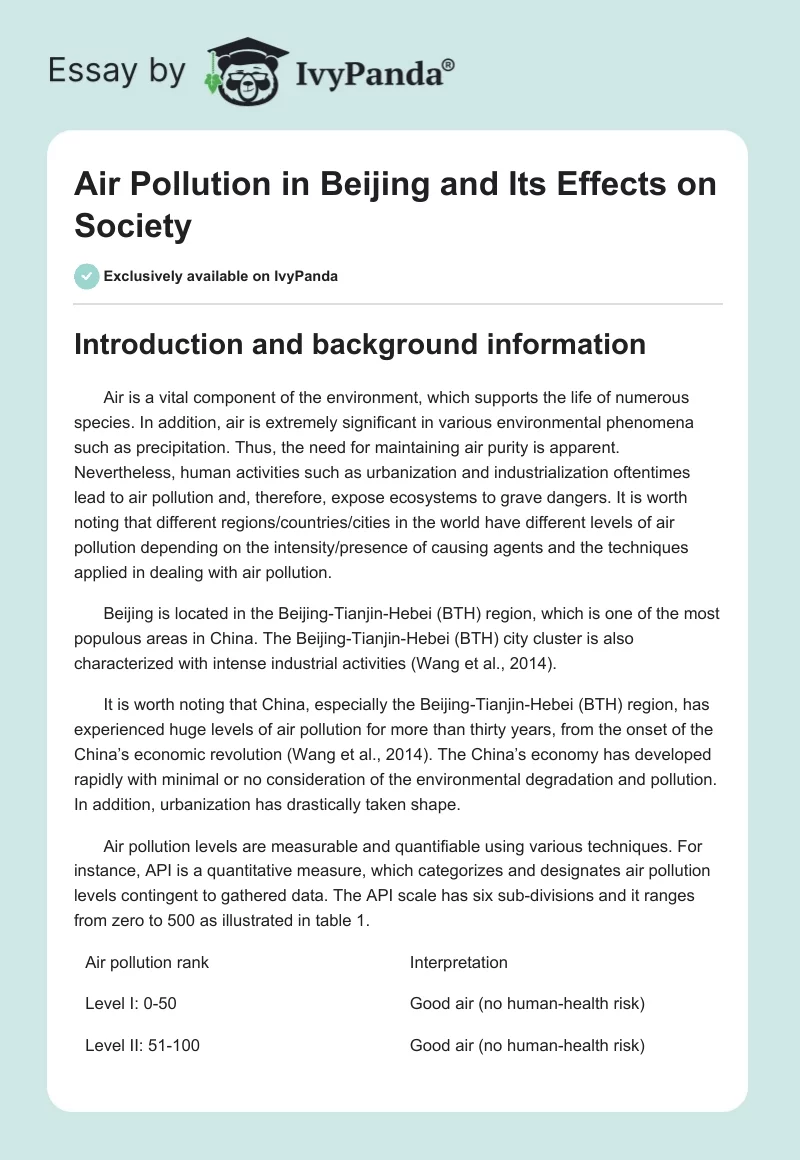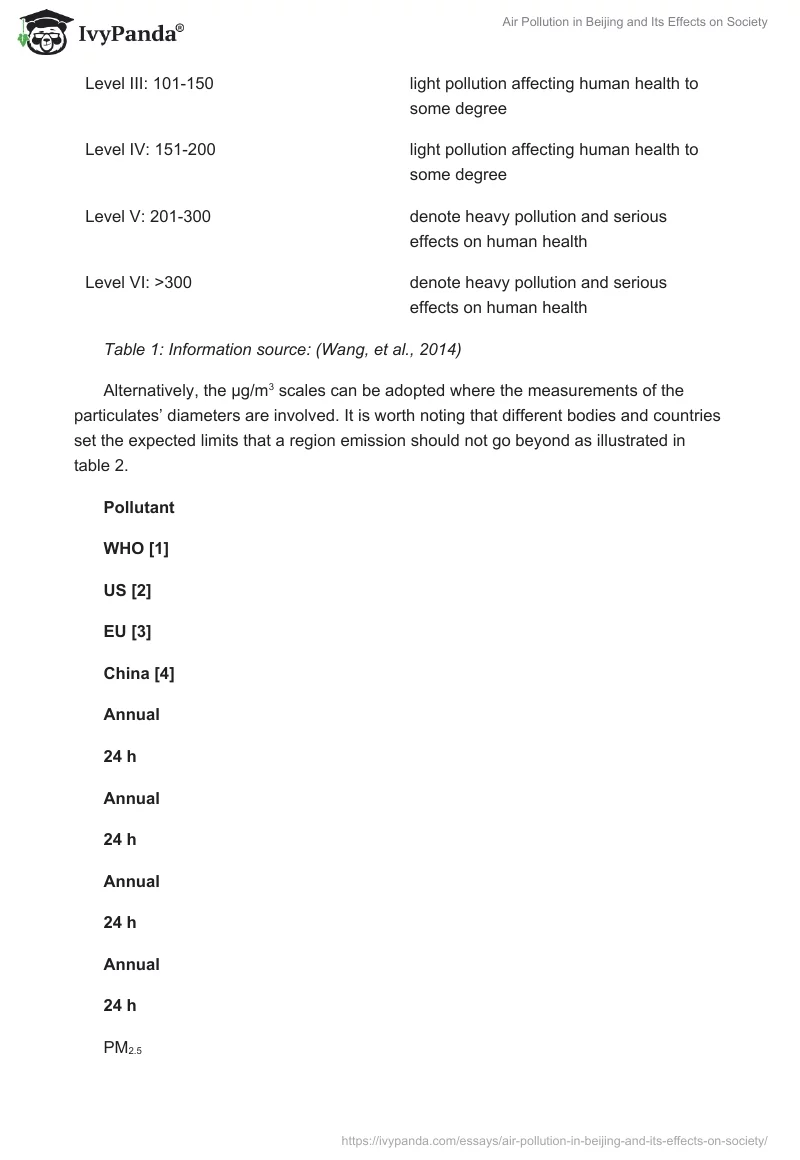Introduction and background information
Air is a vital component of the environment, which supports the life of numerous species. In addition, air is extremely significant in various environmental phenomena such as precipitation. Thus, the need for maintaining air purity is apparent. Nevertheless, human activities such as urbanization and industrialization oftentimes lead to air pollution and, therefore, expose ecosystems to grave dangers. It is worth noting that different regions/countries/cities in the world have different levels of air pollution depending on the intensity/presence of causing agents and the techniques applied in dealing with air pollution.
Beijing is located in the Beijing-Tianjin-Hebei (BTH) region, which is one of the most populous areas in China. The Beijing-Tianjin-Hebei (BTH) city cluster is also characterized with intense industrial activities (Wang et al., 2014).
It is worth noting that China, especially the Beijing-Tianjin-Hebei (BTH) region, has experienced huge levels of air pollution for more than thirty years, from the onset of the China’s economic revolution (Wang et al., 2014). The China’s economy has developed rapidly with minimal or no consideration of the environmental degradation and pollution. In addition, urbanization has drastically taken shape.
Air pollution levels are measurable and quantifiable using various techniques. For instance, API is a quantitative measure, which categorizes and designates air pollution levels contingent to gathered data. The API scale has six sub-divisions and it ranges from zero to 500 as illustrated in table 1.
Table 1: Information source: (Wang, et al., 2014)
Alternatively, the µg/m3 scales can be adopted where the measurements of the particulates’ diameters are involved. It is worth noting that different bodies and countries set the expected limits that a region emission should not go beyond as illustrated in table 2.
Table 2. Source: (Lü, Liang, Feng, Li, & Liu, 2015).
The current air pollution levels in Beijing are among the highest in the world. It is imperative to note authorities and other stakeholders adopt hourly-based techniques to collect air pollution data. At times, the hourly concentration of the PM2.5, PM10, SO2, and NO2 go beyond the recommended levels. For instance, the average 2013 levels went beyond any of the EU, USA, WHO, and China guidelines by more than two times. A case in point, on 12th January 2013, the air in Beijing registered 886 μg/m3, 35 times the WHO recommendations (Lü et al., 2015).
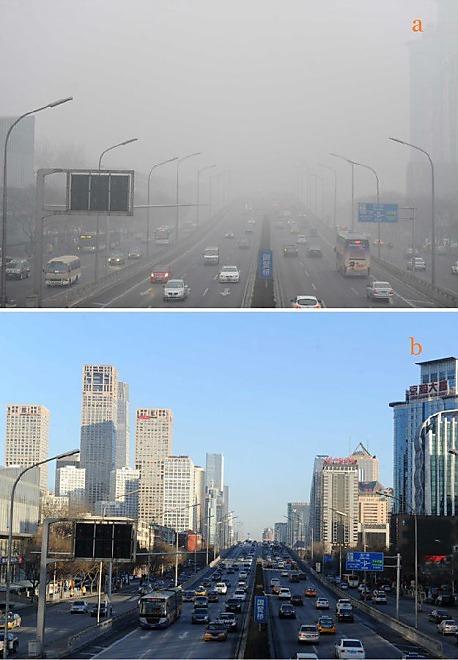
This research paper discusses the various effects of air pollution in Beijing, which include health, economic, and social/lifestyle effects among others.
Literature review
Although air pollution in Beijing has a history of more than three decades, intensive studies about the associated effects started less than ten years ago. Kan, Chen, and Hong (2009) noted that by 2009, insignificant number of studies on long-term effects of air pollution in China had been done. The study noted that studies from other regions, including North America and Europe, could not be pertinent in making conclusions on the effects of air pollution in Beijing since the regions’ emissions and pollution levels are relatively lower than the pollution in China.
The escalating air pollution levels witnessed from 2013 prompted researchers and authors to investigate the risks associated with air pollution.
Guo et al. (2013) investigated the association between increased mortalities and air pollution in Beijing. The study adopted retrospective regression analysis over eight regions in the city. The study revealed that all air pollutants, including PM2.5, PM10, SO2, and NO2 significantly affected years of life lost (YLL). It was also evident that air pollution affected people of different genders and ages differently. Women demonstrated higher degrees of susceptibility compared to their male counterparts. The elderly (people above 65 years) were at higher risks relative to those below 65 years. The study concluded that increased air pollution in Beijing resulted in increased YLL and, therefore, air pollution should be checked and effective mitigation measures adopted.
In a similar study, He, Fan, and Zhou (2016) found that air pollution in Beijing is highly associated with increased mortality rates, especially in children under 10 years and people above 65 years. However, the study did not reveal any differences in susceptibility between different genders.
Apart from being associated with high mortality rate, air pollution is linked to various health issues. Chung, Zhang, Zhong (2015) noted that air pollution in Beijing could be the source of numerous health problems. Air pollution is among the leading causes of lung cancer and other respiratory health issues. However, the study pointed out that there was a lack of sufficient academic research, especially in China, to prove the associations.
Chung et al. (2015) also noted that there is a great need for the government and other stakeholders to fight the escalating levels of air pollution in Beijing.
Wei et al. (2016) noted that air pollution could be associated with childhood obesity. They did an empirical study (using rodents) to investigate the link between weight gain and air pollution in Beijing. The rodents were divided into two groups, one exposed to filtered air and the other to the polluted Beijing air. Rodents exposed to unfiltered air registered relatively higher weight gains. Moreover, the rodents under unfiltered air developed complications in their respiratory/cardiovascular systems, or had hampered metabolisms.
The experiment also involved two groups of pregnant rodents and their offspring before and after birth. Both the control group and the group under polluted air carried the pregnancies to term but the rodents that were exposed to polluted air had heavier offspring relative to the control group. In addition, continued contact with unfiltered air increased lungs related problems, and other complications.
Noting the insufficiency in the number of studies on the health effects of air pollution in Beijing, Liang et al. (2014) endeavoured to establish the association between PM2.5, a key air pollutant in Beijing, with influenza.
Using data collected for five years, (2008-2013), Liang et al. (2014) established that PM2.5 is a key causative factor for human influenza in Beijing.
Other health complications that have been linked to air pollution in Beijing include cardiovascular diseases such as thrombosis and inflammation (Rich et al., 2012).
Jain (2014) article reviewed tourism-related economic implications of air pollution in Beijing. It was evident that the number of tourists dropped significantly from 2012 to 2013. Some of the implications included loss of jobs and reduced GDP contribution.
On international relationship, Topal and Chung (2014) observed that air pollution could be a source of tensions between China and her neighbors. Thus, Beijing’s levels of emission could have adverse political and inter-boundary issues. The paper suggested the need for collaboration between China and her neighbors in fighting air pollution.
Discussion
Driving factors and Causes of the Beijing pollution
Unregulated coal energy consumption
A substantial percentage of China’s energy production depends on coal. Coal account for approximately 70% of the total energy consumption (Bhatnagar, 2014). Emissions from coal plants account for an extensive part of the Beijing pollution. It is worth noting that a majority of the new coal power plant have emission regulation mechanisms but the drives to cut the cost of production hinder the operation of the equipment (Bhatnagar, 2014).
Vehicle manufacturing and vehicle emissions
The China’s automobile demand is one of the highest globally. In addition, the China’s vehicle manufacturing industry is the world leader in vehicle sale (Bhatnagar, 2014). As such, vehicle-related emissions have huge impacts on the Beijing air. In 2012, for instance, Hong Feng (a former Beijing official) noted that vehicle-related emissions accounted for approximately 22% PM2.5 particulate in the Beijing air (Bhatnagar, 2014).
Corruption and the lack of proper law enforcement
China has numerous unimplemented environmental conservation laws. The lack of law enforcement is propagated by the high levels of corruption in the China’s law enforcing agencies.
In addition, perpetual violation of environmental pollution laws is not prohibited by the legal system in China. Companies that charged in courts for violation receive the same treatment (with no extra fines for perpetual violators) regardless the number of previous violations.
Companies disregard environmental pollution laws even viewing court fines as part of costs of their operations. The contempt of the laws has been linked to the laissez-faire enforcement approaches adopted by agencies.
The decentralization versus centralization dilemma
The China’s administrative system has been in a dilemma of whether to adopt a centralized or a decentralized approach of governing the vast country. In addition, disconnects exist amid the central and the local governments creating misunderstanding and more ambiguities. As implementation of set rules has faced huge challenges. For instance, laws set in Beijing face the risk of non-implementation on the grounds of jurisdiction ambiguities.
The organizational maze and bureaucracies are some of the factors that thwart the efforts of fighting pollution. Hierarchical issues can be linked to almost 70% of the inefficiency in law enforcement on pollution (Bhatnagar, 2014).
Economic growth at all cost
The China’s quest for economic revolution does not regard the need for sustainability in development. The Growth at all cost spirit has driven the China’s economic development revolution for the last three decades. As such, manufacturers have been pursuing profitability and economic gains at the cost of environmental degradation and pollution (Bhatnagar, 2014).
The wind and air pollution
Hana et al. (2015) associated concentrations of air pollution with the wind patterns in Beijing. The study noted that high speed of wind 4 m/sec was associated with cleaner air while low-speed wind increased air pollution. In addition, poor city planning and impervious building structures escalated the intensities of air pollution in the city.
Effects of the Beijing pollution
Health effects
From the literature review in this paper, it is evident that air pollution in Beijing has huge adverse effects on human health. The issue of linking the air pollution in Beijing with health problems has raised contrivances for a long time. Consequently, numerous studies have been carried out to establish the facts and to find the truth. Many studies have linked the Beijing air pollution to serious health problems, including cancer, asthma, childhood obesity, and respiratory complications among other health issues (Chung et al., 2015; He et al., 2016). As such, air pollution is linked to a substantial number of mortalities.
Economic effects
The paradox of economic growth at all cost is evident in Beijing. Although the economic development is one of the key factors that propel Beijing’s air pollution, the sustainability of the development can never be realized. Besides, the cost of noncompliance with environmental regulations is evident. In 2010, for instance, China lost approximately $230 billion (almost 4% of China’s GDP that year) because of air pollution and environmental degradation (Bhatnagar, 2014).
Air pollution and the associated acid rains have caused huge losses on households, especially farmers. In 2003, for example, Chinese farmers lost 30 billion yuan (approximately $4.39 billion) when acid rains and air pollution destroyed their crops.
Economic activities are sometimes postponed or cancelled when suspended pollutants hinder visibility. Traffic jams and accidents are oftentimes experienced in the city hindering the normal economic operations.
In December 2015, (when the air impurities went beyond 500) the Chinese authorities had no alternative but to issue a red alert, which had huge economic implications. During the red alert, the number of vehicles on the roads reduced. Workers, students, and a majority of the Beijing population were ordered to stay indoors. Industrial production within Beijing was strictly controlled and learning institutions shut. The public transport was adversely affected with pedestrians advised to wear masks (Chen & Spegele, 2015).
The 2014 Beijing marathon was adversely affected by air pollution in the city. On the day that the marathon was held, the level of pollution was extremely high. PM2.5 the 19th of October 2014 went beyond the recommended levels to record alarming 344 μg/m3. Many athletes could not tolerate the high levels of PM2.5 and, therefore, did not participate in the marathon. Among those that did compete, a substantial number was not able to complete the race (Bhatnagar, 2014).
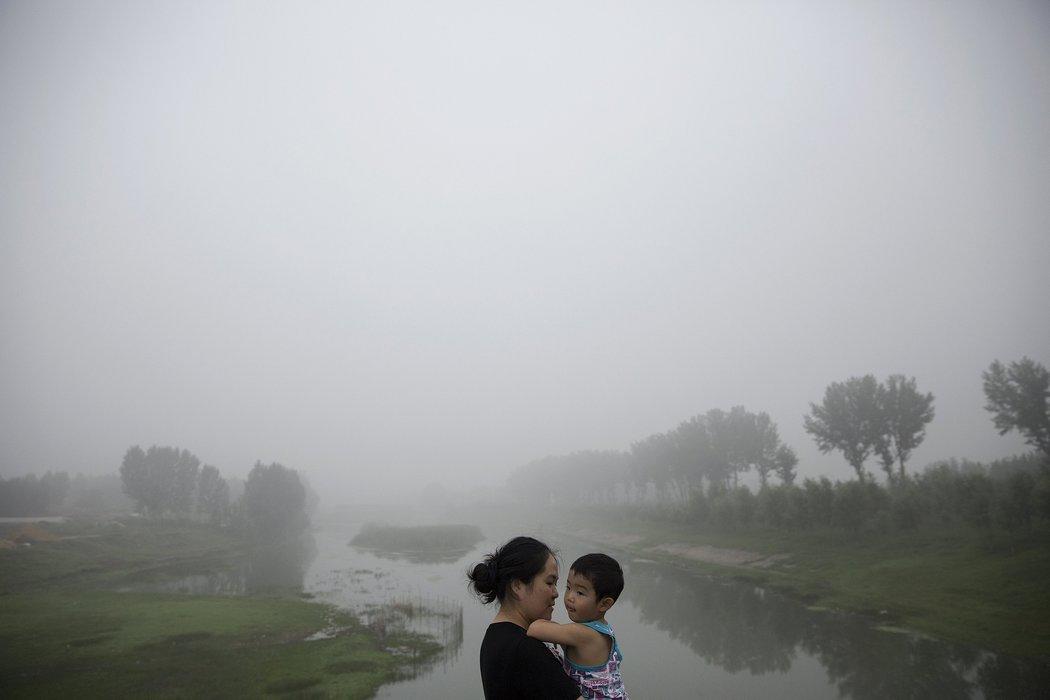
Tourism
The tourism industry in Beijing has been adversely affected air pollution. It is worth noting that China is one of the most popular destinations of international tourists. As such, the tourism industry is a vital sector of China’s economy. Moreover, the Chinese government has invested heavily in promoting tourism since it considers the industry a significant tool in raising GDP of the country.
Air pollution in Beijing, therefore, denies China millions of dollars since tourists require healthy environment and effective transport and communication systems.
Source: (Jain, 2014)
From the table, it is evident that the year-on-year tourist visits in China are decreasing. The Beijing smog resulting from air pollution has been linked to the drop in tourist visiting China (Jain, 2014).
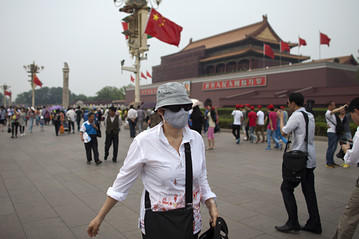
It is worth noting that the dropping numbers of tourism have rippling effects on the China’s economy. In 2012, for instance, tourism and travel industry contributed 9.3% of the total GDP. The industry also was the source of jobs to many Chinese accounting for 3% of the total jobs created in China. Therefore, a lot is at stake if tourists evade China on the grounds of air pollution (Jain, 2014).
Lifestyle changes effects
Air pollution in Beijing prevents outdoor activities, including physical activities. It is worth noting that the Chinese are traditionally known for carrying out outdoor physical activities as a lifestyle and part of social life. However, with the huge presence of air pollutant, it is difficult to carry out any physical activity (Lü et al., 2015).
Socio-political effects
The levels of air pollution and the associated health effects and deaths have been published and broadcast by the local and international media. Therefore, the Chinese public is aware of the adverse effects linked to air pollution in Beijing. Consequently, cases of civil unrest have been reported in the city and other parts of the country. Many Chinese have used the social media platforms to vent their frustrations (Gardner, 2015). It is also worth noting that air pollution raises inter-boundary political concerns, with tensions between China and her neighbors being prevalent.
Urban-rural migration
People living in Beijing are extremely afraid of the various effects of air pollution. As such, they do all they can to be safe from the unfiltered polluted air. Children of the well to do families are taken to schools that have air purification systems. Some of the families who cannot afford the huge bills associated with air purification are now moving to the rural parts of China (Gardner, 2015).
Mitigation measures
Averting air pollution in Beijing is vital. Numerous adverse effects, including effects on health, economy, and political sectors are evident. Therefore, mitigating efforts are necessitated. There are numerous challenges that face the war against air pollution. Nevertheless, stakeholders have attempted to curb air pollution in Beijing.
For instance, the Chinese government has put in place some measures to fight air pollution and environmental degradation. The government, for instance, has imposed regulations to fight industrial emissions. The use of the Two Control Zone (TCZ) was put in place to ensure that industries comply with emission regulations by adopting pollution control technology (Tanaka, 2015).
Bhatnagar (2014) indicates that China is attempting to deal with fuel issues. Implementation of more stringent standards on vehicle-related emissions by embracing technologies that enhance efficient fuel consumptions. The efforts are aimed at reducing particulate matter by 80% and Nitric Oxide emissions by 30%.
Liu, Zhou, and Li (2016) notes that Beijing authorities consider ventilation corridors a solution to the escalating air pollution. As such, plans are underway to construct system ventilation corridors to deal with the numerous adverse effects. However, Liu et al., (2016) have the implication that adopting the ventilation corridor technique will not be effective, especially during winter. They instead propose the adoption of alternative methods that are more comprehensive since the air pollution menace is somewhat complex. Thus, stakeholders in fighting the Beijing air pollution should deal with the sources of the pollution as opposed to dealing with the effects/symptoms.
Lü et al. (2015) suggest the establishment green spaces within and near the city of Beijing to reduce the intensity and concentration of pollutants. They further suggest that people with the need to do physical exercises should consider the green space to avoid the adverse health effects associated with physical activities in polluted air. Further, Lü et al. (2015) suggest the reduction in overdependence on vehicles. Vehicles in Beijing contribute a significant percentage of NO2. Therefore, reducing motorized traffic by talking walks and other low fuel consumption means of transportation will greatly reduce vehicle-related emissions.
Conclusion
The air pollution levels in Beijing are among the highest globally. Industrialization, urbanization, and the lack of proper mitigation frameworks are some of the causative agents. This paper has delved into the various effects of air pollution in Beijing.
First, air pollution in Beijing is adversely affecting the health of the city dwellers and people from the entire region. Diseases such as asthma, lung cancer, influenza, and obesity have been associated with the air pollution in Beijing. Consequently, air pollution in Beijing is a major cause of deaths in the city.
Second, numerous economic losses result from the high levels of pollution in Beijing. The cancellations and delays of economic activities due to air pollution have huge economic implications. Moreover, the costs incurred in dealing with the effects of air pollution increases the Beijing’s economic burden. In addition, economic losses are realized due to the reducing numbers of tourists.
Third, air pollution affects outdoor physical activities. As such, the Chinese traditional physical activities in Beijing are hampered and, therefore, a vital aspect of the Chinese lifestyle is affected.
Fourth, socio-political effects are evident in Beijing where the public are protesting against the rising air pollution levels and their associated health effects.
Lastly, air pollution in Beijing is leading to urban-rural migration where some people are moving from Beijing to the rural China.
Recommendations
- The China’s government should deal with air pollution by addressing the causes. Stringent laws should be put in place and implemented.
- More research should be carried out to investigate more effects of air pollution. The public should also be sensitized about the adverse effects.
References
Bhatnagar, V. (2014). The Chinese Pollution Problem and the Politics of “Airpocalypse”. Inquiries Journal, 6(1), 1-3.
Chen, T.-P., & Spegele, B. (2015). China’s Red Alert on Air Pollution Puts Focus on Regulators. The Wall Street Journal. Web.
Chung, K. F., Zhang, J,…, & Zhong, N. (2015). Haze, Health and Disease. Journal of Thoracic Disease, 7(1), 1-2. Web.
Deng, C. (2013). Pollution Halves Visitors to Beijing. The Wall Street Journal. Web.
Gardner, D. (2015). Beijing’s Smog is Increasingly Toxic for China’s Politicians. The Guardian. Web.
Guo, Y., Li, S., Tian, Z., Pan, X., Zhang, J., & Williams, G. (2013). The Burden of Air Pollution on Years of Life Lost in Beijing, China, 2004-08: retrospective regression analysis of daily deaths. BMJ, 347. Web.
Hana, L., Zhoua, W., Lia, W., Mesheshab, D. T., Lic, L., & Zhengd, M. (2015). Meteorological and Urban Landscape Factors on Severe Air Pollution in Beijing. Journal of the Air & Waste Management Association, 65(7), 782-787. Web.
He, G., Fan, M., & Zhou, M. (2016). The Effect of Air Pollution on Mortality in China: Evidence from the 2008 Beijing Olympic Games. Journal of Environmental Economics and Management, 79, 18–39. Web.
Jain, R. (2014). China’s Pollution Debacle and Destabilization of Inbound International Tourism: A Critique. Transnational Corporations Review, 6(3), 213-227.
Kan, H., Chen, B., & Hong, C. (2009). Health Impact of Outdoor Air Pollution in China: Current Knowledge and Future Research Needs. Environmental Health Perspective, 117 (5). Web.
Levin, D. (2015). Study Links Polluted Air in China to 1.6 Million Deaths a Year. The New York Times. Web.
Liang, Y., Fang, L., Pan, H., Zhang, K., Kan, H., Brook, J. R., & Sun, Q. (2014). PM2.5 in Beijing- Temporal Pattern and Its Association With Influenza. Environmental Health, 13(2014), 102. Web.
Liu, Y., Zhou, Y., & Li, Y. (2016). Air corridors: Ventilating Beijing Cannot Fix Pollution. International Weekly Journal of Science, 532(7600), 441. Web.
Lü, J., Liang, L., Feng, Y., Li, R., & Liu, Y. (2015). Air Pollution Exposure and Physical Activity in China: Current Knowledge, Public Health Implications, and Future Research Needs. International Journal of Environmental Research and Public Health, 12(11), 14887–14897. Web.
Luo, Y., Chen, H., Zhu, Q., Peng, C., Yang, G., Yang, Y., & Zhang, Y. (2013). Relationship between Air Pollutants and Economic Development of the Provincial Capital Cities in China during the Past Decade. Plose One. Web.
Rich, D. Q., Kipen, H. M., Huang, W., Wang, G., Wang, Y., Zhu, P.,… Zhang, J. (2012). Association Between Changes in Air Pollution Levels During the Beijing Olympics and Biomarkers of Inflammation and Thrombosis in Healthy Young Adults. Journal of American Medical Association, 307(19), 2068-2078. Web.
Tanaka, S. (2015). Environmental Regulations on Air Pollution in China and Their Impact on Infant Mortality. Journal of Health Economics 42, 90–103. Web.
Topal, C., & Chung, Y. (2014). China’s Off-the-Chart Air Pollution: Why It Matters (and Not Only to the Chinese) – Part Two. The National Bureau of Asian Research. Web.
Wang, L., Zhang, N., Liu, Z., Sun, Y., Ji, D., & Wang, Y. (2014). The Influence of Climate Factors, Meteorological Conditions, and Boundary-Layer Structure on Severe Haze Pollution in the Beijing-Tianjin-Hebei Region during January 2013. Advances in Meteorology, 2014 (2014), 1-14. Web.
Wei, Y., Zhang, J. (., Li, Z., Gow, A., Chung, K. F., Hu, M.,… Tang, X. (2016). Chronic exposure to air pollution particles increases the risk of obesity and metabolic syndrome: findings from a natural experiment in Beijing. The FASEB Journal. Web.

